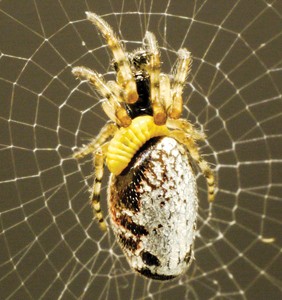Diabolical Wasps Turn Spiders Into Zombies

By Samba Lampich
Spiders are often perceived as fearless and terrifying creatures able to hold their own against any predator. But when it comes to the Reclinervellus nielseni wasp — which lives in Australia and Japan — the spider is no match. This species of wasp has the gruesome ability to turn the Cyclosa argenteoalba species of spiders into arachnid zombies that they feast on until their usefulness runs out.
An Unwilling Host
Scientist have known about this one-sided relationship, where the female wasp stings the spider and uses poison to temporarily paralyze it while it injects the arachnid with eggs. The eggs hatch into larvae, which feast on the spiders’ blood and kill them before using their web to pupate.
What remained unclear was if, and how, the larva controlled what kind of web the spider built. For a time, scientists thought that the wasp had drained so much of the spider’s body fluid that it caused the arachnid to build a web that just happened to be strong enough to support a wasp cocoon.
However, a new study, published in the The Journal of Experimental Biology, suggests that the wasp larva may be hijacking the nervous system of spider and controlling just what kind of web it built. Dr Keizo Takasuka and researchers from Kobe University in southern Japan, who published the study, video recorded 23 spiders that had the parasitic wasp larvae and observed the kinds of webs they built compared to those built by spiders that did not have the parasite.
Weaving A Wicked Web Of Death
The Cyclosa argenteoalba spider builds two types of webs: circular, sticky orb webs that catch prey and a simpler ‘resting web’ the spiders used for molting.
The researchers noted that the host spiders built a modified and reinforced version of the ‘resting web’, a cocoon web. The researchers observed that the spiders work for around 10 hours and built the special web that is 40 times stronger than any it would usually build.
As the wasp larva prepared to pupate, it steered the spider back to the center of the cocoon web and devoured it before entering the pupal stage. “[The] cocoon web has to endure falling debris, the elements and animal strikes for a long time — at least four to five times longer than [a] resting web,” Takasuka told Live Science.
The researchers also found that even after the larva was removed, the spider still continued building the reinforced web.
According to Dr. Takasuka, this strongly suggests that the larva releases a manipulative substance that reacts with the spider’s endocrine system, causing the spider to think it was molting and weave the special web. While the researchers think this substance may be a hormone that mimics those of the spider that induces molting further, research is needed to confirm their suspicions.
Extension Questions
- What other parasitic creatures can turn their hosts into zombies?
- How are human beings parasites and/or hosts?